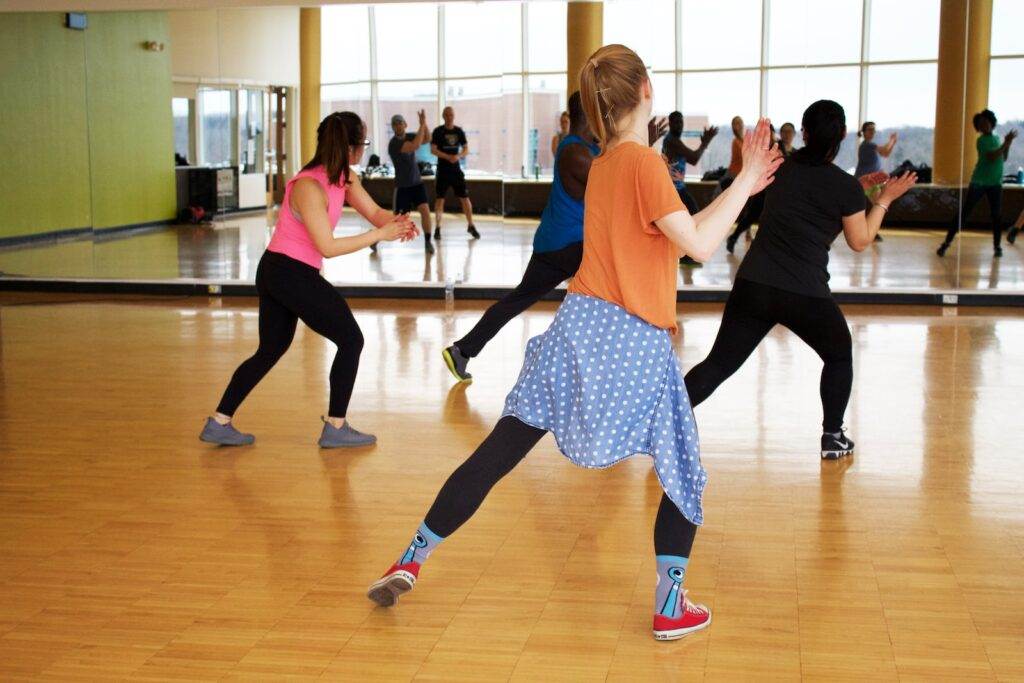Stress is an unavoidable thread that runs through our lives. However, there is a glimmer of hope in the world of cardio exercises, which have been shown to be powerful tools for fighting stress and improving one’s mood and health. As we go through this investigation, we’ll find the best cardio exercises. Prior to starting any new exercise program, it is crucial to consult a healthcare professional.
Table of Contents
The Science Behind Cardio and Stress Relief
The Connection Between Exercise and Mental Health
According to the American Psychological Association (APA), regular physical activity can have a positive impact on mental health by reducing stress, anxiety, and depression1American Psychological Association. (2018). Exercise fuels the brain’s stress buffers. Retrieved from https://www.apa.org/helpcenter/exercise-stress. When we engage in cardio workouts, our body releases endorphins, which are natural mood elevators.
How Cardio Improves Mood and Reduces Stress
Cardio exercises increase blood flow to the brain, providing it with essential nutrients and oxygen. This enhanced blood flow stimulates the production of new brain cells, which helps improve cognitive function and emotional well-being2Erickson, K. I., Voss, M. W., Prakash, R. S., Basak, C., Szabo, A., Chaddock, L., … Kramer, A. F. (2011). Exercise training increases size of hippocampus and improves memory. Proceedings of the National Academy of Sciences, 108(7), 3017–3022. https://www.pnas.org/doi/full/10.1073/pnas.1015950108. Furthermore, cardio workouts can increase the production of serotonin, a neurotransmitter that contributes to feelings of happiness and well-being3Mikkelsen, K., Stojanovska, L., Polenakovic, M., Bosevski, M., & Apostolopoulos, V. (2017). Exercise and mental health. Maturitas, 106, 48–56. https://www.maturitas.org/article/S0378-5122(17)30856-3/fulltext.

The Best Cardio Exercises to Bust Stress
Running
Benefits of Running
Running is an effective way to relieve stress and improve mood. It has been found to be effective in reducing symptoms of depression and increasing overall happiness. Running also helps improve cardiovascular health, build endurance, and burn calories. Some of the benefits of running include:
- Reduces stress and improves mood: Running is a powerful tool for reducing stress and improving mood, as it triggers the release of endorphins, natural mood elevators.
- Improves cardiovascular health: Running is an aerobic exercise that strengthens the heart and lungs, increases endurance, and reduces the risk of heart disease.
- Enhances muscle strength: Running engages multiple muscle groups, including the legs, core, and arms, which helps to improve overall muscle strength.
- Increases flexibility: Running can improve flexibility in the legs, hips, and back, reducing the risk of injury.
- Promotes weight loss: Running is a calorie-burning exercise that can help with weight loss and maintaining a healthy weight.
Running Tips for Beginners
Start with a comfortable pace and gradually increase your speed and distance as you become more comfortable. Make sure to invest in proper running shoes to prevent injuries. Try to find a scenic route to run, which can be more enjoyable and help you relax.
- Start with a comfortable pace: Begin with a slow pace and gradually increase speed and distance as you become more comfortable.
- Invest in proper running shoes: Invest in a pair of good-quality running shoes to prevent injury and ensure proper support for your feet.
- Warm up before running: Do some light cardio and stretching exercises to warm up your muscles and prevent injury.
- Stay hydrated: Drink plenty of water before, during, and after your run to stay hydrated.
- Set achievable goals: Start with small, achievable goals and gradually increase the distance and intensity of your runs as you progress.
Cycling
Benefits of Cycling
Cycling is a low-impact, enjoyable exercise that helps relieve stress and elevate mood. It strengthens leg muscles, improves cardiovascular health, and increases endurance4Oja, P., Titze, S., Bauman, A., de Geus, B., Krenn, P., Reger-Nash, B., & Kohlberger, T. (2011). Health benefits of cycling: a systematic review. Scandinavian Journal of Medicine & Science in Sports, 21(4), 496–509. https://onlinelibrary.wiley.com/doi/10.1111/j.1600-0838.2011.01299.x. Some of the benefits of cycling include:
- Reduces stress and improves mood: Cycling, like other forms of cardio exercise, can trigger the release of endorphins, natural mood elevators, reducing stress and improving mood.
- Improves cardiovascular health: Cycling is an aerobic exercise that strengthens the heart and lungs, increases endurance, and reduces the risk of heart disease.
- Strengthens leg muscles: Cycling is a great workout for the legs, including the quadriceps, hamstrings, and calf muscles, helping to improve overall leg strength.
- Low-impact: Cycling is a low-impact form of exercise, making it a great option for individuals with joint pain or other physical limitations.
- Promotes weight loss: Cycling burns calories, making it an effective tool for weight loss and maintaining a healthy weight.
Cycling Tips for Beginners
Begin with shorter rides and gradually increase the distance and intensity as you become more confident. Don’t forget to wear a helmet and follow traffic rules for safety. Try to find a scenic route to cycle, which can be more enjoyable and help you relax.
- Start with shorter rides: Begin with shorter rides and gradually increase distance and intensity as you become more confident.
- Wear a helmet: Wear a helmet to protect your head and prevent injury.
- Follow traffic rules: Always follow traffic rules and be mindful of other road users when cycling.
- Invest in a good-quality bike: Invest in a good-quality bike that fits your body and provides proper support and comfort.
- Warm up before cycling: Do some light cardio and stretching exercises to warm up your muscles and prevent injury.
Swimming
Benefits of Swimming
Swimming is a full-body workout that provides numerous physical and mental health benefits. In addition to reducing stress and improving mood, swimming also:
- Improves cardiovascular health: Swimming is an aerobic exercise that strengthens the heart and lungs, increases endurance, and reduces the risk of heart disease.
- Enhances flexibility and strengthens muscles: Swimming involves using multiple muscle groups, which helps to improve overall flexibility and strengthen muscles, including the arms, legs, back, and core.
- Low-impact exercise: Swimming is a low-impact exercise, making it ideal for those with joint pain or injury.
- Promotes relaxation: The buoyancy of the water can help reduce tension in the muscles and promote relaxation, leading to improved mental well-being.
Swimming Tips for Beginners
Start with basic swimming techniques and gradually progress to more advanced strokes as you become more comfortable in the water. Make sure to warm up before swimming and stretch afterward to prevent injuries.
- Start with basic swimming techniques: Focus on proper form and technique, such as using the correct arm and leg movements, and breathing effectively.
- Gradually progress to more advanced strokes: As you become more comfortable in the water, start incorporating more advanced strokes, such as the breaststroke or butterfly.
- Warm up before swimming: Stretch and do some light cardio exercises to warm up your muscles and prevent injury.
- Stay hydrated: Drink plenty of water before, during, and after your swim to stay hydrated.
- Wear proper gear: Invest in a swimsuit that fits well and is comfortable, as well as goggles to protect your eyes and a swim cap to keep your hair out of your face.
Jump Rope
Benefits of Jump Rope
Jump rope is an effective and fun cardio workout that helps relieve stress and boost mood. It enhances coordination, strengthens leg muscles, and increases cardiovascular endurance. Some of the benefits of jump rope include:
- Reduces stress and improves mood: Jump rope triggers the release of endorphins, natural mood elevators, reducing stress and improving mood.
- Enhances coordination: Jump rope is a full-body workout that improves coordination and balance.
- Strengthens leg muscles: Jump rope is a great workout for the legs, including the quadriceps, hamstrings, and calf muscles, helping to improve overall leg strength.
- Increases cardiovascular endurance: Jump rope is an intense form of cardio exercise that increases cardiovascular endurance and helps improve overall cardiovascular health.
- Portable and convenient: Jump rope is a portable and convenient form of exercise that can be done anywhere and at any time.
Jump Rope Tips for Beginners
Begin with a slower pace and gradually increase the speed and intensity as you become more comfortable. Make sure to jump on a soft surface, such as a mat, to minimize the impact on your joints.
- Start with a slower pace: Begin with a slower pace and gradually increase the speed and intensity as you become more comfortable.
- Jump on a soft surface: Jump on a soft surface, such as a mat, to minimize the impact on your joints.
- Focus on proper technique: Focus on proper technique, including jumping with both feet and using your arms to help with momentum.
- Incorporate different jump rope exercises: Incorporate different jump rope exercises, such as double unders, criss-cross, and side-to-side, to keep your workout interesting and challenging.
- Warm up before jumping rope: Do some light cardio and stretching exercises to warm up your muscles and prevent injury.
Dancing
Benefits of Dancing
Dancing is an enjoyable and social way to bust stress and boost mood. It helps improve cardiovascular health, enhances balance and coordination, and strengthens muscles.
- Enjoyable and social way to relieve stress and improve mood
- Improves cardiovascular health
- Enhances balance and coordination
- Strengthens muscles
Dancing Tips for Beginners
- Join a dance class or follow online tutorials
- Dance at your own pace and comfort level
- Focus on proper technique to minimize the risk of injury
- Enjoy the social interaction and energetic atmosphere of dancing
- Experiment with different dance styles to find what you enjoy the most.
Stair Climbing
Benefits of Stair Climbing
- Effective cardio workout
- Helps alleviate stress and boost mood
- Strengthens lower body muscles
- Improves cardiovascular endurance
Stair Climbing Tips for Beginners
- Start with a moderate pace and gradually increase the intensity as you become more comfortable
- Use handrails for balance and support when needed
- Focus on proper form and technique to minimize the risk of injury
- Incorporate stair climbing into your overall fitness routine for maximum benefits
- Consider joining a gym or fitness center with a stair climbing machine or taking a stair climbing class for additional support and guidance.
Rowing
Benefits of Rowing
Rowing is a full-body, low-impact workout that helps reduce stress and improve mood. It strengthens muscles, improves cardiovascular health, and increases endurance.
- Full-body, low-impact workout
- Helps reduce stress and improve mood
- Strengthens muscles
- Improves cardiovascular health
- Increases endurance
Rowing Tips for Beginners
Start with proper form and technique to avoid injury. Gradually increase the intensity and duration of your rowing sessions as you become more comfortable.
- Start with proper form and technique to avoid injury
- Gradually increase the intensity and duration of your rowing sessions as you become more comfortable
- Focus on proper technique and form to minimize the risk of injury
- Seek guidance from a professional or experienced rower if needed
- Incorporate rowing into your overall fitness routine for maximum benefits.
Zumba
Benefits of Zumba
Zumba is a fun, dance-based workout that helps reduce stress and improve mood. It combines aerobic exercise with upbeat music, promoting cardiovascular health and overall well-being.
- Fun and energetic way to relieve stress and improve mood
- Combines aerobic exercise with upbeat music
- Promotes cardiovascular health
- Improves overall well-being
Zumba Tips for Beginners
Join a Zumba class or follow online tutorials, and dance at your own pace. Enjoy the social interaction and energetic atmosphere.
- Join a Zumba class or follow online tutorials
- Dance at your own pace and comfort level
- Focus on proper technique to minimize the risk of injury
- Enjoy the social interaction and energetic atmosphere of Zumba
- Experiment with different dance styles to find what you enjoy the most.
Kickboxing
Benefits of Kickboxing
Kickboxing is an intense workout that combines cardiovascular exercise with strength training. It helps relieve stress and improve mood by releasing endorphins, while enhancing balance, flexibility, and coordination.
- Releases endorphins: Kickboxing is an intense workout that combines cardiovascular exercise with strength training, which helps release endorphins and relieve stress.
- Improves mood: By releasing endorphins and improving overall physical health, kickboxing can contribute to an elevated mood and reduce symptoms of stress and anxiety.
- Enhances balance and coordination: Kickboxing requires coordination and balance, which can help improve these skills over time.
- Strengthens muscles: This full-body workout helps strengthen muscles, including the legs, arms, and core.
- Increases flexibility: Kickboxing also helps improve flexibility and overall physical health.
Kickboxing Tips for Beginners
Begin with basic moves and combinations, focusing on proper technique. Gradually progress to more advanced techniques as you become more comfortable and confident.
- Focus on proper technique: Start with basic moves and combinations, focusing on proper form and technique.
- Gradually progress: As you become more comfortable and confident, gradually progress to more advanced techniques.
- Warm up before each session: Make sure to warm up properly before each workout to prevent injury and maximize the effectiveness of your workout.
- Wear proper gear: Wear appropriate gear, such as gloves and hand wraps, to protect your hands and wrists during kickboxing.
- Seek guidance from a professional: Consider taking a kickboxing class or working with a personal trainer to ensure you are using proper form and technique.

Customizing Your Cardio Routine for Maximum Stress Relief
- Finding the Right Exercise Intensity
To reap the mood-boosting benefits of cardio exercises, it’s essential to find the right intensity level. Engaging in moderate to vigorous intensity workouts will help elevate your heart rate and trigger the release of mood-enhancing endorphins. Listen to your body, and adjust the intensity accordingly.
- Incorporating Mindfulness and Breathing Techniques
Integrating mindfulness and deep breathing techniques into your cardio routine can enhance the stress-relieving effects. Focus on your breath and maintain an awareness of your body movements during the exercise. This mindful approach can help you stay present and fully enjoy the workout experience5Zeidan, F., Johnson, S. K., Diamond, B. J., David, Z., & Goolkasian, P. (2010). Mindfulness meditation improves cognition: Evidence of brief mental training. Consciousness and Cognition, 19(2), 597-605. https://www.sciencedirect.com/science/article/abs/pii/S1053810010000681?via%3Dihub.
- Choosing Exercises That You Enjoy
Selecting cardio exercises that you genuinely enjoy will make it easier to maintain consistency and motivation. Experiment with various workouts to find the ones that resonate with you and bring you joy. Incorporating fun and enjoyable activities into your routine can significantly contribute to stress relief and mood improvement.
- Setting Realistic and Achievable Goals
Setting realistic and achievable fitness goals can help you stay motivated and committed to your cardio routine. Break down your goals into smaller, manageable milestones, and celebrate your progress along the way. This approach can lead to a more enjoyable workout experience and contribute to stress reduction and mood enhancement.
Additional Strategies to Complement Cardio Exercises for Stress Relief
- Strength Training and Flexibility Exercises
In addition to cardio exercises, incorporating strength training and flexibility exercises into your fitness routine can also contribute to stress relief and mood enhancement. These exercises can help improve muscle strength, joint mobility, and overall physical health, which can have a positive impact on mental well-being6Penedo, F. J., & Dahn, J. R. (2005). Exercise and well-being: a review of mental and physical health benefits associated with physical activity. Current Opinion in Psychiatry, 18(2), 189-193. https://journals.lww.com/co-psychiatry/Abstract/2005/03000/Exercise_and_well_being__a_review_of_mental_and.13.aspx.
- Proper Nutrition and Hydration
Fueling your body with a well-balanced diet and staying hydrated is essential for optimal mental and physical health. Consuming nutrient-dense foods and drinking enough water can help support your energy levels and mood during your cardio workouts7Firth, J., Gangwisch, J. E., Borisini, A., Wootton, R. E., & Mayer, E. A. (2020). Food and mood: how do diet and nutrition affect mental wellbeing?. BMJ, 369, m2382. https://www.bmj.com/content/369/bmj.m2382.
- Adequate Sleep and Stress Management Techniques
Getting adequate sleep and practicing stress management techniques, such as deep breathing, meditation, or yoga, can further enhance the mood-boosting benefits of your cardio workouts. Prioritizing self-care and managing stress effectively can lead to a happier, healthier lifestyle.
In conclusion, cardio exercises are a powerful tool for busting stress and boosting mood. By tailoring your workout routine, setting achievable goals, and adopting complementary strategies, you can create a holistic approach to mental health, fitness, and well-being.

Creating a Supportive Environment for Your Cardio Routine
- Establishing a Routine and Staying Consistent
Consistency is key when it comes to reaping the stress-relieving and mood-enhancing benefits of cardio exercises. Establish a routine that works for you, and make a commitment to stick with it. Over time, this consistency will contribute to improved mental health, fitness, and well-being.
- Engaging with a Supportive Community
Surrounding yourself with like-minded individuals who share your fitness goals can provide motivation and encouragement. Join local fitness groups, participate in online forums, or attend group exercise classes. Building connections with others can help create a positive and supportive environment for your cardio routine.
- Tracking Your Progress and Celebrating Successes
Keeping track of your progress can help you stay motivated and accountable. Use a fitness tracker or journal to record your workouts, milestones, and achievements. Celebrate your successes, no matter how small, and acknowledge the positive impact your cardio routine has on your stress levels and mood.
- Adjusting Your Routine as Needed
As your fitness level improves and your needs change, it’s important to adjust your cardio routine accordingly. This might involve increasing the intensity or duration of your workouts, incorporating new exercises, or setting new goals. Regularly reassessing your routine can help you stay engaged and maintain long-term success.
By incorporating the best cardio exercises, customizing your routine, and creating a supportive environment, you can effectively bust stress and boost mood. Embrace the journey toward improved mental health, fitness, and well-being, and enjoy the transformative power of cardiovascular workouts.
Overcoming Common Challenges in Maintaining a Cardio Routine
- Dealing with Time Constraints
One of the most common challenges in maintaining a cardio routine is finding the time to exercise. To overcome this, prioritize your workouts by scheduling them in your calendar. Consider incorporating short, high-intensity interval training (HIIT) sessions, which can provide similar benefits to longer, moderate-intensity workouts in a fraction of the time8Gillen, J. B., & Gibala, M. J. (2014). Is high-intensity interval training a time-efficient exercise strategy to improve health and fitness? Applied Physiology, Nutrition, and Metabolism, 39(3), 409-412. https://cdnsciencepub.com/doi/10.1139/apnm-2013-0187..
- Staying Motivated
Maintaining motivation can be challenging, especially when faced with obstacles or setbacks. To stay motivated, focus on the positive effects of your cardio routine on your stress levels and mood. Remind yourself of your progress and goals, and consider rewarding yourself for reaching milestones or maintaining consistency.
- Preventing and Managing Injuries
Injuries can be a setback in any fitness journey. To prevent injuries, make sure to warm up properly before each workout, cool down afterward, and incorporate flexibility and strength training exercises into your routine. If you do sustain an injury, consult a healthcare professional for guidance on recovery and rehabilitation.
- Balancing Cardio with Other Aspects of Life
Achieving a balance between your cardio routine and other aspects of your life is essential for long-term success. Be mindful of your work-life balance, ensure you have time for socializing and relaxation, and prioritize self-care. A well-rounded lifestyle will contribute to overall mental health, fitness, and well-being.
By overcoming these common challenges, you can maintain a consistent and effective cardio routine that helps bust stress and boost mood. Embrace the process, and enjoy the benefits of improved mental health, fitness, and well-being as you continue your cardiovascular exercise journey.

Tips for Staying Engaged and Enjoying Your Cardio Routine
- Vary Your Workouts
Incorporating a variety of cardio exercises into your routine can help keep your workouts interesting and engaging. Mixing up your activities not only prevents boredom but also challenges your body in different ways, promoting overall fitness and well-being.
- Listen to Music or Podcasts
Listening to music or podcasts while you exercise can provide motivation, entertainment, and a distraction from fatigue. Choose upbeat tunes or engaging podcasts to enhance your workout experience and make your cardio sessions more enjoyable9Karageorghis, C. I., & Priest, D. L. (2012). Music in the exercise domain: a review and synthesis (Part II). International Review of Sport and Exercise Psychology, 5(1), 67-84. https://www.tandfonline.com/doi/full/10.1080/1750984X.2011.631027..
- Use Technology to Enhance Your Workouts
Leverage technology to enhance your cardio workouts. Fitness apps, wearables, and online workout programs can help track your progress, provide motivation, and guide you through effective and enjoyable workouts. Explore various options to find the tools that best support your fitness journey10Direito, A., Dale, L. P., Shields, E., Dobson, R., Whittaker, R., & Maddison, R. (2014). Do physical activity and dietary smartphone applications incorporate evidence-based behaviour change techniques?. BMC Public Health, 14(1), 646. https://bmcpublichealth.biomedcentral.com/articles/10.1186/1471-2458-14-646..
- Seek Out New and Exciting Exercise Opportunities
Stay open to new and exciting exercise opportunities, such as trying out a new group fitness class, joining a local sports team, or participating in a charity race. Embracing new challenges and experiences can keep your cardio routine fresh, exciting, and beneficial for your mental health, fitness, and well-being.
In conclusion, the best cardio exercises can effectively bust stress and boost mood. By customizing your routine, creating a supportive environment, overcoming common challenges, and staying engaged, you can foster a sustainable and enjoyable cardio journey. Embrace the transformative power of cardiovascular workouts and experience the profound impact they can have on your mental health, fitness, and well-being.
FAQs
Q. How often should I do cardio workouts?
It is generally recommended to engage in at least 150 minutes of moderate-intensity aerobic activity or 75 minutes of vigorous-intensity aerobic activity per week, spread across multiple days. However, the frequency and duration may vary depending on individual needs and preferences.
Q. Can I combine different types of cardio exercises in one workout session?
Yes, combining different types of cardio exercises can provide a more engaging and well-rounded workout experience. This can help prevent boredom and maintain motivation to stay consistent with your exercise routine.
Q. Is it better to do cardio exercises in the morning or evening for stress relief and mood improvement?
The best time for cardio exercises largely depends on individual preferences and schedules. Some people may prefer morning workouts to start their day energized, while others may find evening workouts help them unwind after a long day. Experiment and see what works best for you.
Q. Can I do cardio exercises if I have joint issues or other physical limitations?
Consult with your healthcare professional before starting any exercise program. They can help you choose appropriate low-impact cardio exercises or modifications that are suitable for your specific needs and limitations.
Q. How long does it take to see improvements in stress levels and mood after starting cardio workouts?
While some individuals may experience immediate mood improvements after a single workout session, it may take several weeks of consistent exercise to see more significant changes in stress levels and mood. Consistency is key for long-term benefits.
Q. Is it necessary to consult a healthcare professional before starting a new cardio routine?
It is generally recommended to consult a healthcare professional, especially if you have any pre-existing health conditions, are pregnant, or have been inactive for a long period. They can provide guidance on the most suitable and safe exercise options for your individual needs.
Q. How do I know if my cardio routine is effectively busting stress and boosting mood?
Pay attention to your emotional and physical well-being. If you notice improvements in your mood, reduced stress levels, better sleep, or increased energy, these are signs that your cardio routine is effectively busting stress and boosting mood. Keep in mind that results may vary for each individual, and it may take time to experience the full benefits of a consistent cardio routine.

